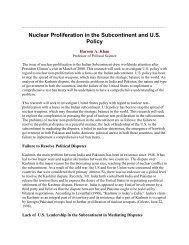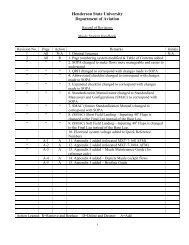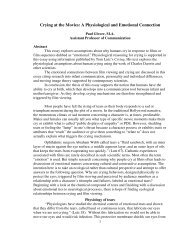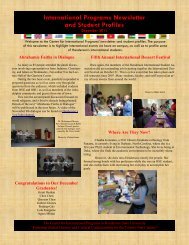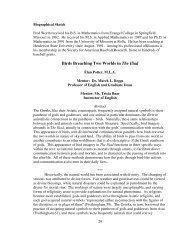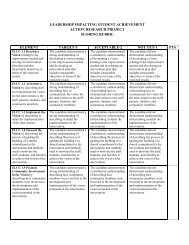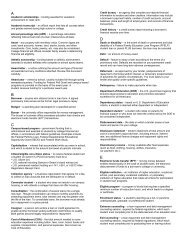Impact of Globalization on World Society - Henderson State University
Impact of Globalization on World Society - Henderson State University
Impact of Globalization on World Society - Henderson State University
You also want an ePaper? Increase the reach of your titles
YUMPU automatically turns print PDFs into web optimized ePapers that Google loves.
Academic Forum 22 2004-05<br />
ABSTRACT<br />
<str<strong>on</strong>g>Impact</str<strong>on</strong>g> <str<strong>on</strong>g>of</str<strong>on</strong>g> <str<strong>on</strong>g>Globalizati<strong>on</strong></str<strong>on</strong>g> <strong>on</strong> <strong>World</strong> <strong>Society</strong><br />
Shanta Sharma, Ph.D.<br />
Pr<str<strong>on</strong>g>of</str<strong>on</strong>g>essor <str<strong>on</strong>g>of</str<strong>on</strong>g> Sociology and Coordinator <str<strong>on</strong>g>of</str<strong>on</strong>g> Ger<strong>on</strong>tology Certificate Program<br />
The purpose <str<strong>on</strong>g>of</str<strong>on</strong>g> this study was to examine the impact <str<strong>on</strong>g>of</str<strong>on</strong>g> globalizati<strong>on</strong> <strong>on</strong> world society.<br />
Research indicates that in the past century there has been worldwide surge in ec<strong>on</strong>omic growth<br />
and more people lifted out <str<strong>on</strong>g>of</str<strong>on</strong>g> poverty than in all human history. <strong>World</strong> poverty has fallen<br />
within past 30 years. Since 1970’s the development in China and India has played a significant<br />
role in reducti<strong>on</strong> <str<strong>on</strong>g>of</str<strong>on</strong>g> the world poverty. However, ec<strong>on</strong>omic growth is unbalanced and uneven<br />
across the globe. The ec<strong>on</strong>omic growth has been c<strong>on</strong>centrated just in fifteen wealthy countries.<br />
Whereas, eighty-nine other countries represent 1.6 billi<strong>on</strong> people or <strong>on</strong>e quarter <str<strong>on</strong>g>of</str<strong>on</strong>g> the world<br />
populati<strong>on</strong> are ec<strong>on</strong>omically worse <str<strong>on</strong>g>of</str<strong>on</strong>g>f than they were ten or more years ago. Sub-Saharan<br />
Africa requires greater focus to deal with poverty. The present uneven ec<strong>on</strong>omic growth trend<br />
has widened the gap between the rich and poor countries. According to ec<strong>on</strong>omic forecasts if<br />
the current pattern <str<strong>on</strong>g>of</str<strong>on</strong>g> uneven ec<strong>on</strong>omic growth c<strong>on</strong>tinues, the poorest countries <str<strong>on</strong>g>of</str<strong>on</strong>g> the world<br />
will grow even poorer while the richest countries will become even richer. Across the world<br />
inequality has affected disproporti<strong>on</strong>ately the children and women <str<strong>on</strong>g>of</str<strong>on</strong>g> poor countries. The<br />
present global uneven ec<strong>on</strong>omic growth has raised a questi<strong>on</strong> can this gap between the rich and<br />
poor nati<strong>on</strong>s will be narrowed rather than widened in the future? This questi<strong>on</strong> has made social<br />
scientists, policy makers, and global internati<strong>on</strong>al instituti<strong>on</strong>s to rethink about the impact <str<strong>on</strong>g>of</str<strong>on</strong>g><br />
globalizati<strong>on</strong> and future <str<strong>on</strong>g>of</str<strong>on</strong>g> rich and poor countries. The impact <str<strong>on</strong>g>of</str<strong>on</strong>g> globalizati<strong>on</strong> has created a<br />
need for global acti<strong>on</strong> and interc<strong>on</strong>nectivity at internati<strong>on</strong>al, nati<strong>on</strong>al, and local levels to make a<br />
human and sustainable world society in the 21st century.<br />
Since the mid-twentieth century globalizati<strong>on</strong> has become a buzzword to talk about<br />
societies, and is defined as a way <str<strong>on</strong>g>of</str<strong>on</strong>g> integrating worldwide government policies, cultures,<br />
societies, social movements, financial markets through trade and exchange <str<strong>on</strong>g>of</str<strong>on</strong>g> ideas (Schaefer<br />
2005). The process <str<strong>on</strong>g>of</str<strong>on</strong>g> globalizati<strong>on</strong> has been accelerated by modern means <str<strong>on</strong>g>of</str<strong>on</strong>g> communicati<strong>on</strong><br />
and transportati<strong>on</strong>, and gives the image that the world is unified globally. It appears that in the<br />
21st century globalizati<strong>on</strong> is an unaltered way and will c<strong>on</strong>tinue even though 75% <str<strong>on</strong>g>of</str<strong>on</strong>g> the<br />
world’s populati<strong>on</strong> has access to daily televisi<strong>on</strong> recepti<strong>on</strong> and <strong>on</strong>ly 20% has access to<br />
c<strong>on</strong>sumer cash or credit (McMichael 2000).<br />
However, pr<str<strong>on</strong>g>of</str<strong>on</strong>g>essi<strong>on</strong>als have differences <str<strong>on</strong>g>of</str<strong>on</strong>g> opini<strong>on</strong> about globalizati<strong>on</strong> and its effect. One<br />
group sees globalizati<strong>on</strong> is a natural result <str<strong>on</strong>g>of</str<strong>on</strong>g> advances in communicati<strong>on</strong> technology,<br />
particularly the Internet and satellite transmissi<strong>on</strong> <str<strong>on</strong>g>of</str<strong>on</strong>g> mass media. Sec<strong>on</strong>d group views it more<br />
critically and sees globalizati<strong>on</strong> as an extensive movement <str<strong>on</strong>g>of</str<strong>on</strong>g> capitalism and related values and<br />
ideas am<strong>on</strong>g the nati<strong>on</strong>s <str<strong>on</strong>g>of</str<strong>on</strong>g> world (Kanter 1997; & Soysa and O’Neal 1999). In fact<br />
globalizati<strong>on</strong> has been underway for several hundred years. It started with col<strong>on</strong>ialism which<br />
fueled ec<strong>on</strong>omic development <str<strong>on</strong>g>of</str<strong>on</strong>g> already wealthy countries by keeping the ec<strong>on</strong>omies <str<strong>on</strong>g>of</str<strong>on</strong>g> the<br />
col<strong>on</strong>ized countries underdeveloped (Frank 1969). In modern times powerful nati<strong>on</strong>s are rarely<br />
27
Academic Forum 22 2004-05<br />
involved in c<strong>on</strong>quest and subjugati<strong>on</strong> <str<strong>on</strong>g>of</str<strong>on</strong>g> weak nati<strong>on</strong>s. Whereas, with the new forms <str<strong>on</strong>g>of</str<strong>on</strong>g><br />
communicati<strong>on</strong> systems, Internet and transportati<strong>on</strong> powerful nati<strong>on</strong>s are able to exploit weaker<br />
countries for their commercial gains. Powerful countries can use weaker countries as a source<br />
<str<strong>on</strong>g>of</str<strong>on</strong>g> cheap raw materials and cheap labor. Because <str<strong>on</strong>g>of</str<strong>on</strong>g> their access to better technology, wealthy<br />
nati<strong>on</strong>s are able to produce higher quality goods at lower price than the poor nati<strong>on</strong>s (Newman<br />
2002; & Smith, 1993). This advantage allows them to have a more favorable balance <str<strong>on</strong>g>of</str<strong>on</strong>g> trade<br />
and ultimately gives them greater c<strong>on</strong>trol <str<strong>on</strong>g>of</str<strong>on</strong>g> the world’s financial resources, and widened<br />
inequality am<strong>on</strong>g the rich and poor nati<strong>on</strong>s (Wallerstein 1974). The following secti<strong>on</strong> will<br />
analyze the impact <str<strong>on</strong>g>of</str<strong>on</strong>g> globalizati<strong>on</strong> <strong>on</strong> world society.<br />
IMPACT OF GLOBALIZATION<br />
According to the United Nati<strong>on</strong>s Development Programme (1996) the gap between<br />
countries has widened, even though there has been worldwide surge in ec<strong>on</strong>omic growth over<br />
the past decades, but it has benefited <strong>on</strong>ly a handful <str<strong>on</strong>g>of</str<strong>on</strong>g> countries. More specifically, the benefit<br />
<str<strong>on</strong>g>of</str<strong>on</strong>g> global ec<strong>on</strong>omic growth has been c<strong>on</strong>centrated in just fifteen countries. Whereas, eightynine<br />
other countries which represent 1.6 billi<strong>on</strong> people or <strong>on</strong>e quarter <str<strong>on</strong>g>of</str<strong>on</strong>g> the world populati<strong>on</strong><br />
are ec<strong>on</strong>omically worse <str<strong>on</strong>g>of</str<strong>on</strong>g>f than they were ten or more years ago (United Nati<strong>on</strong>s Development<br />
Report 1996). Out <str<strong>on</strong>g>of</str<strong>on</strong>g> these eighty-nine countries seventy are low income and developing<br />
countries. There income level has fallen below those <str<strong>on</strong>g>of</str<strong>on</strong>g> the 1960’s and 1970’s. As a result, the<br />
poorest 20 percent <str<strong>on</strong>g>of</str<strong>on</strong>g> the world populati<strong>on</strong> saw their meager share <str<strong>on</strong>g>of</str<strong>on</strong>g> global income cut nearly<br />
in half over the past three decades, while the richest 20 percent <str<strong>on</strong>g>of</str<strong>on</strong>g> the world’s populati<strong>on</strong><br />
increased their share <str<strong>on</strong>g>of</str<strong>on</strong>g> global income by 15 percent in the same period. In other words, the<br />
income share ratio <str<strong>on</strong>g>of</str<strong>on</strong>g> the world’s richest and poorest people have doubled during this time;<br />
increasing from 30:1 to 61:1. The above findings lead to c<strong>on</strong>clude that “in the past 15 years the<br />
world has become more ec<strong>on</strong>omically polarized – both between countries and within countries.<br />
If the present trends c<strong>on</strong>tinue, ec<strong>on</strong>omic disparity between the industrial and developing<br />
nati<strong>on</strong>s will move from inequitable to inhuman”(U.N. Development Programme 1996, P111).<br />
In global society nati<strong>on</strong>s have differing amounts <str<strong>on</strong>g>of</str<strong>on</strong>g> power and want to ensure that their<br />
interests are met. The developed and less developed countries <str<strong>on</strong>g>of</str<strong>on</strong>g> the world experience serious<br />
inequalities in wealth that have immediate c<strong>on</strong>sequences for their citizens. The low-income<br />
countries are poor because <str<strong>on</strong>g>of</str<strong>on</strong>g> the policies and practices and the high income countries pursue in<br />
order to mass a greater share <str<strong>on</strong>g>of</str<strong>on</strong>g> global wealth. Because <str<strong>on</strong>g>of</str<strong>on</strong>g> their policies and practices the lowincome<br />
countries are in a positi<strong>on</strong> <str<strong>on</strong>g>of</str<strong>on</strong>g> relative dependency <strong>on</strong> high-income countries (Renzetti &<br />
Curran 1998). Powerful nati<strong>on</strong>s, like powerful ruling classes, seek to retain their favored<br />
positi<strong>on</strong>s while keeping other nati<strong>on</strong>s in their place. In a global ec<strong>on</strong>omy, such dominance is<br />
accomplished through financial pressure, such as powerful industrialized countries set world<br />
prices <strong>on</strong> certain goods, rather than use brute force (Chase-Dunn and Rubins<strong>on</strong> 1977). The<br />
ec<strong>on</strong>omic base <str<strong>on</strong>g>of</str<strong>on</strong>g> poor countries is weak, therefore they <str<strong>on</strong>g>of</str<strong>on</strong>g>ten have to borrow m<strong>on</strong>ey or buy<br />
manufactured goods <strong>on</strong> credit from wealthy countries. The huge debt they build up locks them<br />
into a downward spiral <str<strong>on</strong>g>of</str<strong>on</strong>g> exploitati<strong>on</strong> and poverty. As a result, they cannot develop an<br />
independent ec<strong>on</strong>omy <str<strong>on</strong>g>of</str<strong>on</strong>g> their own and thus remain dependent <strong>on</strong> wealthy <strong>on</strong>es for their very<br />
survival (Frank 1969). In short, just as upper-class people can exploit and exercise power over<br />
28
Academic Forum 22 2004-05<br />
lower-class people within a society similarly, wealthy countries can exploit poor countries in<br />
the global market place. In c<strong>on</strong>sequence <str<strong>on</strong>g>of</str<strong>on</strong>g> it the global ec<strong>on</strong>omic gap has widened (Newman<br />
2002).<br />
GAP IN INCOME<br />
The average per capita yearly income in Western Europe, the United <strong>State</strong>s, Canada, and<br />
Japan is about $22,000. In the less developed countries South America, Asia, and Africa it’s a<br />
little over $300 (Bradshaw and Wallace 1996). Thus, wealthy countries c<strong>on</strong>tributing 20% <str<strong>on</strong>g>of</str<strong>on</strong>g> the<br />
world’s populati<strong>on</strong> accounts for 65% <str<strong>on</strong>g>of</str<strong>on</strong>g> the world’s income. In c<strong>on</strong>trast, less affluent<br />
developing countries account for 67% <str<strong>on</strong>g>of</str<strong>on</strong>g> the world’s populati<strong>on</strong> but <strong>on</strong>ly 18% <str<strong>on</strong>g>of</str<strong>on</strong>g> its income<br />
(McMichael 1996). Assets hold by the world’s 200 wealthiest individuals total $ One-trilli<strong>on</strong>,<br />
for an average <str<strong>on</strong>g>of</str<strong>on</strong>g> five billi<strong>on</strong> each. After doubling since 1995, there total wealth equals’ the<br />
combined annual income <str<strong>on</strong>g>of</str<strong>on</strong>g> the world’s 2.5 billi<strong>on</strong> poorest people, meanwhile eighty nati<strong>on</strong>s<br />
reported incomes lower than a decade age. Sixty countries have grown steady poorer since<br />
1980. Three Billi<strong>on</strong> people presently live <strong>on</strong> $2 or less per day while 1.3 billi<strong>on</strong> get by <strong>on</strong> $1 or<br />
less (Jeff 2001). The richest three individuals in the world have assets that exceed the gross<br />
domestic product <str<strong>on</strong>g>of</str<strong>on</strong>g> the 48 least developed countries (Crossette 1998). “For instance, the 400<br />
wealthiest U.S. citizens hold financial assets equivalent to <strong>on</strong>e-eighth <str<strong>on</strong>g>of</str<strong>on</strong>g> the gross domestic<br />
product <str<strong>on</strong>g>of</str<strong>on</strong>g> the world’s largest ec<strong>on</strong>omy Their pers<strong>on</strong>al wealth grew by an average $940 milli<strong>on</strong><br />
each from 1997 to 1999 – a per capita daily increase averaging $1,287,67 ($225,962 per hour).<br />
Eighty-six percent <str<strong>on</strong>g>of</str<strong>on</strong>g> stock market gains between 1989 and 1997 flowed to the top 10 percent<br />
<str<strong>on</strong>g>of</str<strong>on</strong>g> U.S. households while 42 percent went to the most well-to-do <strong>on</strong>e percent” (Jeff, 2001 P.2).<br />
Further eye-Opening Statistics reveals disparity between the over-c<strong>on</strong>sumpti<strong>on</strong> and underc<strong>on</strong>sumpti<strong>on</strong><br />
between the wealthy and poor countries (cite in Newman 2002):<br />
1. Wealthy countries c<strong>on</strong>sume 85% as the world’s supply and paper, 79% <str<strong>on</strong>g>of</str<strong>on</strong>g> its steel,<br />
80% <str<strong>on</strong>g>of</str<strong>on</strong>g> all commercial energy, and 45% <str<strong>on</strong>g>of</str<strong>on</strong>g> all meal and fish (Crossette 1998; Kerbo<br />
1991; & Schor 1991, cited in Newman 2002).<br />
2. Grains fed to U.S. Livestock equal the amount <str<strong>on</strong>g>of</str<strong>on</strong>g> food c<strong>on</strong>sumed by the combined<br />
human populati<strong>on</strong>s <str<strong>on</strong>g>of</str<strong>on</strong>g> India and China (McMichael 1996, cited in Newman 2002).<br />
3. A single child born in Western Europe, Japan, or the United <strong>State</strong>s uses as much <str<strong>on</strong>g>of</str<strong>on</strong>g><br />
the earth’s resources as an entire village <str<strong>on</strong>g>of</str<strong>on</strong>g> African children (Steiner 1998, cited in<br />
Newman 2002).<br />
4. Americans spend about $8 billi<strong>on</strong> a year <strong>on</strong> cosmetics-$2 billi<strong>on</strong> more than the<br />
estimated annual amount needed to provide basic educati<strong>on</strong> for every<strong>on</strong>e in the<br />
world (Crossette1998, cited in Newman 2002).<br />
5. Europeans spend about $2 billi<strong>on</strong> a year or more <strong>on</strong> ice cream than the estimated<br />
amount needed to provide clean water and safe sewers for the world’s populati<strong>on</strong><br />
(Crossette1998, cited in Newman 2002).<br />
29
Academic Forum 22 2004-05<br />
GAP IN EDUCATION<br />
The gap in educati<strong>on</strong> and quality <str<strong>on</strong>g>of</str<strong>on</strong>g> life is particularly striking. Only about 20 percent <str<strong>on</strong>g>of</str<strong>on</strong>g><br />
school-age children in poor countries enrolled in Sec<strong>on</strong>dary School compared to 90 percent in<br />
affluent countries. In wealthy countries 40 percent <str<strong>on</strong>g>of</str<strong>on</strong>g> college age people go to college; in poor<br />
countries <strong>on</strong>ly 30 percent do. The number <str<strong>on</strong>g>of</str<strong>on</strong>g> children die before the age <str<strong>on</strong>g>of</str<strong>on</strong>g> five is nearly 20<br />
times higher the age <str<strong>on</strong>g>of</str<strong>on</strong>g> poor countries than in rich <strong>on</strong>e (Bradshaw and Wallace 1996).<br />
It is estimated that about 24 percent <str<strong>on</strong>g>of</str<strong>on</strong>g> the world’s adult populati<strong>on</strong> is illiterate, <str<strong>on</strong>g>of</str<strong>on</strong>g> that 30<br />
percent <str<strong>on</strong>g>of</str<strong>on</strong>g> the world’s female adult populati<strong>on</strong> is illiterate. In low income countries the<br />
illiteracy rate for women is nearly 46 percent (United Nati<strong>on</strong>s Development Programme 1996).<br />
GAP IN MEDICAL TREATMENTS<br />
The vast majority <str<strong>on</strong>g>of</str<strong>on</strong>g> HIV infected people around the world d<strong>on</strong>’t have access to the effective<br />
drug treatments that are available in the west. C<strong>on</strong>sequently, the AIDS cases and AIDS deaths<br />
are dropping in Western industrialized countries but are increasing dramatically in less<br />
developed countries. According to the United Nati<strong>on</strong>s, <str<strong>on</strong>g>of</str<strong>on</strong>g> the 26 milli<strong>on</strong> people worldwide<br />
infected with HIV virus, 30 milli<strong>on</strong> are poor by world standards; living <strong>on</strong> less than $2 a day.<br />
Impoverished countries in Sub-Saharan Africa, al<strong>on</strong>e, account for 69% <str<strong>on</strong>g>of</str<strong>on</strong>g> the <strong>World</strong>’s victims<br />
<str<strong>on</strong>g>of</str<strong>on</strong>g> HIV and AIDS (Will 2000). In Botswana and Zimbabwe, for instance, <strong>on</strong>e in every four<br />
adults is infected. In some major cities, 70% women in prenatal clinics test positive for HIV<br />
(Altman 1998). In 1999 al<strong>on</strong>e, more than 2 milli<strong>on</strong> Africans died <str<strong>on</strong>g>of</str<strong>on</strong>g> AIDS. That’s more than<br />
five times the number <str<strong>on</strong>g>of</str<strong>on</strong>g> AIDS-related deaths in the United <strong>State</strong>s in nearly two decades (Will<br />
2000), and it is estimated that between <strong>on</strong>e half and two thirds <str<strong>on</strong>g>of</str<strong>on</strong>g> 15 years olds in these African<br />
countries will eventually die <str<strong>on</strong>g>of</str<strong>on</strong>g> AIDS (Altman 2000).<br />
THE GLOBAL ECONOMIC INEQUALITY<br />
Trends in global inequality are found both between and within countries. Inequality between<br />
the countries has been characterized by two divergent trends in recent decades. The gap<br />
between the richest and the poorest countries over the past 40 years has been widened and a<br />
significant number <str<strong>on</strong>g>of</str<strong>on</strong>g> countries have fallen further behind compared not <strong>on</strong>ly to industrial<br />
countries but to other developing countries also. The income distributi<strong>on</strong> between countries has<br />
c<strong>on</strong>sequently worsened. However, at the most populous <strong>on</strong>es, the gap between their average<br />
incomes and that <str<strong>on</strong>g>of</str<strong>on</strong>g> industrial countries has begun to narrow. Overall, inter-country inequality<br />
weighted by populati<strong>on</strong> has decreased as a result, China and India account for the bulk <str<strong>on</strong>g>of</str<strong>on</strong>g> this<br />
improvement while inter-country inequality has improved; however inequality within many <str<strong>on</strong>g>of</str<strong>on</strong>g><br />
the most populous countries with a large number <str<strong>on</strong>g>of</str<strong>on</strong>g> poor has increased modestly (<strong>World</strong> Bank,<br />
October, 2002).<br />
30
Academic Forum 22 2004-05<br />
ECONOMIC INEQUALITY AND POVERTY<br />
The United Nati<strong>on</strong>s Development Programme (1996) created three basic minimal essential<br />
criteria which are essential for human requirements (to be well nourished, to be able to<br />
reproduce, and to be educated) to measure the poverty, which was defined as Capability<br />
Poverty. According to Capability Poverty as a measure, the number <str<strong>on</strong>g>of</str<strong>on</strong>g> people who are poor<br />
world wide increased from 1.3 billi<strong>on</strong> (33 percent) to 1.6 billi<strong>on</strong> (37 percent). Capability<br />
poverty appears to be most widespread in South Asia. In Africa, both income poverty and<br />
capability poverty are high. In c<strong>on</strong>trast many countries in Latin America have d<strong>on</strong>e well in<br />
addressing capability poverty but income poverty remains severe. The global poverty is<br />
disproporti<strong>on</strong>ately found in the United <strong>State</strong>s am<strong>on</strong>g women and children also (Renzetti &<br />
Curran 1998).<br />
GENDER AND GLOBAL POVERTY<br />
Few societies in the world treat women as well as men. Inequality between men and women<br />
are not necessarily less in high income countries, but in disadvantaged countries <strong>on</strong> global<br />
scale, women are likely to be even more disadvantaged. Women in these countries experience<br />
double deprivati<strong>on</strong>. The deprivati<strong>on</strong> <str<strong>on</strong>g>of</str<strong>on</strong>g> living in a poor country and depravati<strong>on</strong> imposed<br />
because they are women. According to United Nati<strong>on</strong>s women represent 60 percent <str<strong>on</strong>g>of</str<strong>on</strong>g> world<br />
populati<strong>on</strong> and perform nearly two-thirds <str<strong>on</strong>g>of</str<strong>on</strong>g> all working hours, they receive <strong>on</strong>ly <strong>on</strong>e-tenth <str<strong>on</strong>g>of</str<strong>on</strong>g><br />
world income and own less than <strong>on</strong>e percent <str<strong>on</strong>g>of</str<strong>on</strong>g> world property (United Nati<strong>on</strong>s Commissi<strong>on</strong> <strong>on</strong><br />
the status <str<strong>on</strong>g>of</str<strong>on</strong>g> women 1980).<br />
Further, across the strata women are more likely than men to be illiterate. It is estimated<br />
that 24 percent <str<strong>on</strong>g>of</str<strong>on</strong>g> the world’s adult populati<strong>on</strong> is illiterate, <str<strong>on</strong>g>of</str<strong>on</strong>g> that 30 percent <str<strong>on</strong>g>of</str<strong>on</strong>g> the world’s<br />
female adult populati<strong>on</strong> is illiterate. In low income countries the illiteracy rate for women is<br />
nearly 46 percent (United Nati<strong>on</strong>s Development Programme 1996). Indeed in most countries<br />
throughout the world, women are the most disadvantaged <str<strong>on</strong>g>of</str<strong>on</strong>g> the disadvantaged.<br />
CHILDREN AND GLOBAL POVERTY<br />
The burden <str<strong>on</strong>g>of</str<strong>on</strong>g> poverty is spread unevenly throughout the world with populati<strong>on</strong> <str<strong>on</strong>g>of</str<strong>on</strong>g> low<br />
income countries suffering is far greater due to more severe poverty than other countries in the<br />
global stratificati<strong>on</strong> hierarchy. In low-income countries the poorest households tend to be those<br />
with the greatest number <str<strong>on</strong>g>of</str<strong>on</strong>g> children or ec<strong>on</strong>omically dependent members (elderly or diseased<br />
people). Twenty five milli<strong>on</strong> children between the ages <str<strong>on</strong>g>of</str<strong>on</strong>g> five and fourteen are in the paid<br />
labor free in virtually in all countries, including United <strong>State</strong>s, it is particularly prevalent in<br />
Asia, where 150 milli<strong>on</strong> children are in the labor force and in Africa where approximately 80<br />
milli<strong>on</strong> children are working (Renzetti & Curran 1998). According to Development Specialist<br />
Susan George (1999), “Half <str<strong>on</strong>g>of</str<strong>on</strong>g> these milli<strong>on</strong>s <str<strong>on</strong>g>of</str<strong>on</strong>g> child labourers working in “outrageous<br />
c<strong>on</strong>diti<strong>on</strong>s” are under 14 years old. The advantage for corporati<strong>on</strong>s is that they receive “three<br />
compliant and defenseless children for the price <str<strong>on</strong>g>of</str<strong>on</strong>g> <strong>on</strong>e adult. The result <str<strong>on</strong>g>of</str<strong>on</strong>g> repressi<strong>on</strong> is to<br />
drive down wages and replace adults”. For example in India, the numbers <str<strong>on</strong>g>of</str<strong>on</strong>g> working children<br />
31
Academic Forum 22 2004-05<br />
and jobless adults are roughly the same. The practice [i.e., child labour] perpetuates poverty.<br />
These children grow up to become the next generati<strong>on</strong> <str<strong>on</strong>g>of</str<strong>on</strong>g> uneducated and untrained adults (Jehl<br />
1997). With the <strong>World</strong> Trade Organizati<strong>on</strong> legislating for the rights’ <str<strong>on</strong>g>of</str<strong>on</strong>g> corporati<strong>on</strong>s in the<br />
name <str<strong>on</strong>g>of</str<strong>on</strong>g> “free trade: nati<strong>on</strong>s are unable to prohibit child labour without violating internati<strong>on</strong>al<br />
trade rules enforced by Western instituti<strong>on</strong>s The resp<strong>on</strong>se <str<strong>on</strong>g>of</str<strong>on</strong>g> the Western Powers to this state <str<strong>on</strong>g>of</str<strong>on</strong>g><br />
affairs is instructive. The U.S. Government for instance has resorted <strong>on</strong>ly to the insignificant<br />
public relati<strong>on</strong>s stunt <str<strong>on</strong>g>of</str<strong>on</strong>g> requesting companies to adopt a ‘voluntary’ code <str<strong>on</strong>g>of</str<strong>on</strong>g> c<strong>on</strong>duct<br />
(Collingsworth 1997). According to Internati<strong>on</strong>al Labor organizati<strong>on</strong> children’s work<br />
c<strong>on</strong>diti<strong>on</strong>s are frequently exploitative and abusive. Work l<strong>on</strong>g hours in unhealthy envir<strong>on</strong>ment<br />
for subsistence wages. In Pakistan, for example nearly 10,000 children under the age <str<strong>on</strong>g>of</str<strong>on</strong>g><br />
fourteen work 10 hours a day hard-sticking leather soccer balls, for a daily wage <str<strong>on</strong>g>of</str<strong>on</strong>g> about $1.20<br />
(Greenhouse 1997). Children beating, impris<strong>on</strong>ment, homeless, and aband<strong>on</strong>ment by parents<br />
are comm<strong>on</strong>. Children <str<strong>on</strong>g>of</str<strong>on</strong>g> six years can be found <strong>on</strong> street. Nearly 13 milli<strong>on</strong> children <strong>on</strong> streets<br />
in Latin American countries. In most Latin American cities begging, selling sex or drugs or<br />
stealing is in order to survive. Children sleep <strong>on</strong> the sidewalks, in alley under bridges and even<br />
in sewer tunnels (El Nasser 1994). In Brazil, several hundred street children are murdered each<br />
year by the police (Larmer 1992).<br />
“The rise <str<strong>on</strong>g>of</str<strong>on</strong>g> global inequality and impoverishment within the current order has therefore<br />
been enormous, systematic and relentless. Western pro-corporate policies are however,<br />
domestic as well as internati<strong>on</strong>al, resulting in the increase in domestic impoverishment and<br />
inequality. Thus, even within the richest countries inequalities have widened and poverty<br />
increased “(Ahmed 2002., P. 13).<br />
WHERE ARE WE WITH GLOBALIZATION?<br />
The evidence suggests that in the past century more advances have been seen in global<br />
prosperity and more people lifted out <str<strong>on</strong>g>of</str<strong>on</strong>g> poverty than in all human history. There are many<br />
reas<strong>on</strong>s for this achievement, but globalizati<strong>on</strong> has played an important catalytic role. <strong>World</strong><br />
poverty has fallen dramatically in the past 30 years. For example, since 1970’s the<br />
development in China and India has played a significant role in reducti<strong>on</strong> <str<strong>on</strong>g>of</str<strong>on</strong>g> the world poverty.<br />
However, ec<strong>on</strong>omic growth is not balanced across the globe. Some countries have witnessed<br />
tremendous growth and others have fallen in poverty. For example the Sub-Saharan Africa<br />
requires greater focus to deal with poverty (Barro 2002). The present uneven ec<strong>on</strong>omic growth<br />
trend has widened the gap between developed and developing countries. According to<br />
ec<strong>on</strong>omic forecasts if the current pattern <str<strong>on</strong>g>of</str<strong>on</strong>g> uneven ec<strong>on</strong>omic growth c<strong>on</strong>tinues, the poorest<br />
countries <str<strong>on</strong>g>of</str<strong>on</strong>g> the world will grow even poorer while the richest countries will become even<br />
richer. For example it is estimated that by 2030, global producti<strong>on</strong> will triple. However in<br />
Sub-Sahara Africa, per capita income will fall to just $32 a year, whereas in high-income<br />
countries, average per- capita income will approach $40,000. Many <str<strong>on</strong>g>of</str<strong>on</strong>g> the countries <str<strong>on</strong>g>of</str<strong>on</strong>g> East<br />
Asia are expected to catch up to the high-income countries in terms <str<strong>on</strong>g>of</str<strong>on</strong>g> per-capita income. By<br />
2050, china’s per capita income is not likely to approach that level until at least 2080, and<br />
India’s will not reach the $40,000 per capita mark until about 2130 the twenty sec<strong>on</strong>d century<br />
(United Nati<strong>on</strong>s Development Programme 1996). The present world unbalanced and uneven<br />
32
Academic Forum 22 2004-05<br />
ec<strong>on</strong>omic growth has raised a questi<strong>on</strong> can this gap between the rich and poor nati<strong>on</strong>s will be<br />
narrowed rather than widened in the future? This questi<strong>on</strong> has made pr<str<strong>on</strong>g>of</str<strong>on</strong>g>essi<strong>on</strong>als and global<br />
society to rethink about the impact globalizati<strong>on</strong> and future <str<strong>on</strong>g>of</str<strong>on</strong>g> rich and poor countries (Renzetti<br />
and Curran 1998).<br />
RETHINKING AND SUGGESTIONS TO NARROW THE GAP<br />
A number <str<strong>on</strong>g>of</str<strong>on</strong>g> social scientists believe that it is possible to narrow the gap, but they stress<br />
that our goals must be reordered. Instead <str<strong>on</strong>g>of</str<strong>on</strong>g> c<strong>on</strong>centrating <strong>on</strong> the rate <str<strong>on</strong>g>of</str<strong>on</strong>g> ec<strong>on</strong>omic growth,<br />
social scientists and policy makers should pay more attenti<strong>on</strong> to the quality <str<strong>on</strong>g>of</str<strong>on</strong>g> ec<strong>on</strong>omic<br />
growth. Ec<strong>on</strong>omic growth for the human development, such as improvement in health and<br />
educati<strong>on</strong>; higher standards <str<strong>on</strong>g>of</str<strong>on</strong>g> living, and sustain natural resources, should be the priority if we<br />
want to avoid future world “gargantuan in its excesses grotesque in its human and ec<strong>on</strong>omic<br />
inequalities” (United Nati<strong>on</strong>s Development Programme 1996, P.8). If we c<strong>on</strong>tinue to focus <strong>on</strong><br />
the rate <str<strong>on</strong>g>of</str<strong>on</strong>g> ec<strong>on</strong>omic growth <strong>on</strong>ly, we will likely to create a world where people will be<br />
“jobless, voiceless, rootless, futureless, and ruthless (United Nati<strong>on</strong>s Development Programme<br />
1996).<br />
Ahmed (2002), proposed that “ ----the <strong>on</strong>ly real way to address the escalating social,<br />
ec<strong>on</strong>omic and political problems faced by the majority <str<strong>on</strong>g>of</str<strong>on</strong>g> the world’s populati<strong>on</strong> as a result <str<strong>on</strong>g>of</str<strong>on</strong>g><br />
globalizati<strong>on</strong> is to transfer the unjust structures resp<strong>on</strong>sible for these problems. The current<br />
world order is geared inherently to fulfill the interests <str<strong>on</strong>g>of</str<strong>on</strong>g> corporate elite based primarily in the<br />
West, directly at the expenses <str<strong>on</strong>g>of</str<strong>on</strong>g> the rights, and well-being <str<strong>on</strong>g>of</str<strong>on</strong>g> hundreds <str<strong>on</strong>g>of</str<strong>on</strong>g> milli<strong>on</strong>s <str<strong>on</strong>g>of</str<strong>on</strong>g> people<br />
around the world. Unless <strong>World</strong> order undergoes a meaningful and drastic transformati<strong>on</strong> <str<strong>on</strong>g>of</str<strong>on</strong>g><br />
structure the basis <str<strong>on</strong>g>of</str<strong>on</strong>g> a fundamental re-evaluati<strong>on</strong> <str<strong>on</strong>g>of</str<strong>on</strong>g> values, ethics and world view, this order<br />
will c<strong>on</strong>tinue to be increasingly engulfed by a crisis <str<strong>on</strong>g>of</str<strong>on</strong>g> its own making with devastating<br />
c<strong>on</strong>sequences”(P. 27 ).<br />
A detailed <strong>World</strong> Bank study (2000/2001) c<strong>on</strong>cluded that ec<strong>on</strong>omic growth is crucial but<br />
<str<strong>on</strong>g>of</str<strong>on</strong>g>ten not sufficient to create c<strong>on</strong>diti<strong>on</strong>s in which the world’s poorest people can improve their<br />
lives. But we also recognized the fundamental role <str<strong>on</strong>g>of</str<strong>on</strong>g> instituti<strong>on</strong>s and social changes to strength<br />
the development processes and the inclusi<strong>on</strong> <str<strong>on</strong>g>of</str<strong>on</strong>g> poor people. The study made recommendati<strong>on</strong>s<br />
that the developing countries, governments at all levels, d<strong>on</strong>or countries, internati<strong>on</strong>al agencies,<br />
N.G.O.’s, civil society, and local communities mobilize behind three priority areas:<br />
1. Opportunity: Expanding ec<strong>on</strong>omic opportunity for poor people by stimulating ec<strong>on</strong>omic<br />
growth, making markets work better for poor people and working for their inclusi<strong>on</strong>,<br />
particularly by building up their assets, such as land and educati<strong>on</strong> (P.2.).<br />
2. Empowerment: Strengthening the ability <str<strong>on</strong>g>of</str<strong>on</strong>g> poor people to shape decisi<strong>on</strong>s that affect their<br />
lives and removing discriminati<strong>on</strong> based <strong>on</strong> gender, race, ethnically and social status (P.2.).<br />
3. Security: Reducing poor people’s vulnerability to sickness, ec<strong>on</strong>omic shocks, crop failure<br />
unemployment, natural disasters and violence and helping them cope when such misfortunes<br />
occur. Advances in these areas are complementary. Each is important in its own right and each<br />
33
Academic Forum 22 2004-05<br />
enhances the others. These priorities can allow the poor to have greater independence and<br />
security in their day-to-day lives: for example, (a) empowering women and other socially<br />
disadvantaged groups expand their range <str<strong>on</strong>g>of</str<strong>on</strong>g> ec<strong>on</strong>omic opportunities, and (b) strengthening poor<br />
people’s organizati<strong>on</strong>s and their involvement in decisi<strong>on</strong> making processes enable them to<br />
press for improved services and for policy choices that resp<strong>on</strong>d to their needs. Finally, making<br />
poor people less vulnerable makes it easier for them to take advantage <str<strong>on</strong>g>of</str<strong>on</strong>g> potential market<br />
opportunities (P.2.). These priorities can allow the poor to have greater independence and<br />
security in their day to day lives, and would create opportunities to participate in the market.<br />
Further, <strong>World</strong> Bank in <strong>World</strong> Development Report (2003) made the following suggesti<strong>on</strong>s<br />
to work with the problem <str<strong>on</strong>g>of</str<strong>on</strong>g> the poverty which involves cooperati<strong>on</strong> at local, nati<strong>on</strong>al and<br />
internati<strong>on</strong>al levels.<br />
1. New alliances are needed at the local, nati<strong>on</strong>al and global levels to better address the<br />
problem <str<strong>on</strong>g>of</str<strong>on</strong>g> poverty. The burden for development must be shared widely.<br />
2. Rich countries must further open their markets and cut agricultural subsidies that deplete<br />
income in third world farmers, and they must increase the flow <str<strong>on</strong>g>of</str<strong>on</strong>g> aids, medicines, and new<br />
technologies to developing countries.<br />
3. Governments in the developing world in turn must become more accountable and<br />
transparent, and ensure that poor people are able to obtain secure large tenure, as well as access<br />
to educati<strong>on</strong>, health care, and other basic services. The burden <str<strong>on</strong>g>of</str<strong>on</strong>g> guaranteeing sustainable<br />
development must be shared locally, nati<strong>on</strong>ally, and globally.<br />
4. Developing Countries need to promote participati<strong>on</strong> and subscribe democracy; inclusiveness<br />
and transparency as they build the instituti<strong>on</strong>s, need to manage their resources.<br />
5. Rich countries need to increase aid, cut poor country debts, their markets to developing<br />
countries exporters and help transfer technologies needed to prevent diseases, increase energy<br />
efficiency and bolster agricultural productivity.<br />
6. Civil <strong>Society</strong> organizati<strong>on</strong>s c<strong>on</strong>tribute when they serve as a voice for dispersed<br />
interdependent provides independent verificati<strong>on</strong> <str<strong>on</strong>g>of</str<strong>on</strong>g> public, private and n<strong>on</strong>-governmental<br />
performance.<br />
7. Private firms c<strong>on</strong>tribute when they commit to sustainability in their daily operati<strong>on</strong>s, and<br />
create incentives to pursue their interests while advancing envir<strong>on</strong>mental and social objectives.<br />
Lastly, the <strong>World</strong> Development Corporati<strong>on</strong> (WDC) proposed a corporati<strong>on</strong> <str<strong>on</strong>g>of</str<strong>on</strong>g> all<br />
multinati<strong>on</strong>al corporati<strong>on</strong>s to bring technology credit access to world markets and management<br />
know-how to improvised areas. Its projects would need to be subsidized at first but should<br />
become pr<str<strong>on</strong>g>of</str<strong>on</strong>g>itable in the l<strong>on</strong>g run. In additi<strong>on</strong>, linking global corporati<strong>on</strong>s to local projects<br />
34
Academic Forum 22 2004-05<br />
would create pr<str<strong>on</strong>g>of</str<strong>on</strong>g>itable endeavors in order to reduce poverty permanently and irreversibly<br />
(Lodge 2002).<br />
CONCLUSION<br />
In sum, it can be c<strong>on</strong>cluded that globalizati<strong>on</strong> has significantly improved the world<br />
ec<strong>on</strong>omy, but due to unbalanced and uneven ec<strong>on</strong>omic growth the world’s social and poverty<br />
problems are magnified. The interc<strong>on</strong>nectivity am<strong>on</strong>g world nati<strong>on</strong>s has created a need for a<br />
global collective acti<strong>on</strong> to combat the world poverty and create a humanitarian and sustainable<br />
global world in the 21 st century. In order to make globalizati<strong>on</strong> sustainable and viable requires<br />
focus from below which involves interdependence at the grassroots level that aims to protect,<br />
restore, and nurture the envir<strong>on</strong>ment; to enhance ordinary people’s access to the basic resources<br />
they need to live a dignified existence to democratize local, nati<strong>on</strong>al, transnati<strong>on</strong>al political<br />
instituti<strong>on</strong>s, and to ease tensi<strong>on</strong>s and prevent violent c<strong>on</strong>flict between power centers and<br />
authority structures (Brecher, Childs & Culter 1993).<br />
BIBLIOGRAPHY<br />
Ahmed, N.M., 2000. “The <str<strong>on</strong>g>Impact</str<strong>on</strong>g> <str<strong>on</strong>g>of</str<strong>on</strong>g> <str<strong>on</strong>g>Globalizati<strong>on</strong></str<strong>on</strong>g> the Instituti<strong>on</strong>alizati<strong>on</strong> <str<strong>on</strong>g>of</str<strong>on</strong>g> Social Crisis”.<br />
Posted: January, 11, 2002. WWW.mediam<strong>on</strong>itors.net/mosaddeq28.html<br />
Altman, L.K., 1998. “Parts <str<strong>on</strong>g>of</str<strong>on</strong>g> Africa Showing H.I.V. in 1 in 4 Adults.” New York Times, June<br />
24.<br />
Altman, L.K., 2000. “UN warning AIDs imperil Africa’s Youth.” New York Times, June 28.<br />
Banet, Richard J. 1991. “Reflecti<strong>on</strong>s: The uses <str<strong>on</strong>g>of</str<strong>on</strong>g> Forces.” The New Yorker, April 29: 82-95.<br />
Barro, Robert J. 2002. The U.N. is Dead Wr<strong>on</strong>g <strong>on</strong> Poverty and Inequality. Business Week,<br />
5/6/2002, Issue 3781, P24, 1 P, 1c.<br />
Bradshaw, Y.W., and Wallace, M. 1996. Global Inequality. Thousand Oaks, CA: Pine Forge<br />
Press.<br />
Brecher, Jeremy, John Brown Childs, and Jill Cutler. 1993. Global Visi<strong>on</strong>: Bey<strong>on</strong>d the New<br />
<strong>World</strong> Order: Bost<strong>on</strong>, MA: South End Press.<br />
Chase-Dunn, C and Rubins<strong>on</strong>, R.T., 1977. “Toward a structural Perspective <strong>on</strong> the <strong>World</strong><br />
System.” Politics and <strong>Society</strong>, 7, 453-476.<br />
Collingsworth, T. 1997. “Child Labour in Global Ec<strong>on</strong>omy: Foreign Policy in Focus, Vol. 2,<br />
No 36, October.<br />
Crossette, B.1998. “K<str<strong>on</strong>g>of</str<strong>on</strong>g>i Annan’s ast<strong>on</strong>ishing facts.” New York Times. September, 27.<br />
35
Academic Forum 22 2004-05<br />
El Nasser, H. 1994. “On border Life is a Sewer for “Tunnel” Orphans. USA Today, March 25.<br />
Frank, A.G., 1969. “Capitalism and Underdevelopment in Latin America. New York: M<strong>on</strong>thly<br />
Review Press.<br />
George, Susan. 1999. The Lugan Report: On Preserving Capitalism in the Twenty-First<br />
Century, Pluto Press, L<strong>on</strong>d<strong>on</strong>. P. 176.<br />
Greenhouse, S. 1997. “Sporting Goods C<strong>on</strong>cerns agree to Combat Sale <str<strong>on</strong>g>of</str<strong>on</strong>g> Soccer balls Made<br />
by Children”. New York Times, February, P.A12.<br />
Jehl, S. H., 1997, September 25. “King cott<strong>on</strong> exacts a tragic toll from the young. New York<br />
Times, P.A4.<br />
Jeff, Gates, 2001. With <str<strong>on</strong>g>Globalizati<strong>on</strong></str<strong>on</strong>g>, poverty is optimal. Humanist, Sept/Oct, Vol. 61 Issues<br />
5, P 4. 1/2 P. Pp. 1-3.<br />
Kanter, Rosabeth Moss, 1997. <strong>World</strong> Class: Thriving Locally in The Global Ec<strong>on</strong>omy. New<br />
York: Touchst<strong>on</strong>e Brooks, 1997.<br />
Kerbo, H.R., 1991. Social Stratificati<strong>on</strong> and Inequality. New York: McGraw Hill.<br />
Larmer, B., 1992. “Dead End Kids.” Newsweek (May 25): Pp. 23-40.<br />
Lodge, George C., 2000. The Corporate Key. Using Big Business to Fight B Global Poverty.<br />
Foreign Affairs, July/August, Vol81, Issue 4, P13, 6p.<br />
McMichael, P., 2000. Development and Social Change: A Global Perspective. Sec<strong>on</strong>d<br />
Editi<strong>on</strong>. Pine Forge Press. A sage Publicati<strong>on</strong> Company, Thousand Oaks, California, 91320.<br />
McMichael, P. 1996. Development and Social Change: A global perspective. Thousand Oaks,<br />
C A: Pine Forge press.<br />
Newman, D.M., 2002. Sociology, Exploring the Architecture <str<strong>on</strong>g>of</str<strong>on</strong>g> Everyday Life. Fourth Editi<strong>on</strong>,<br />
Pine Forge Press, an Imprint <str<strong>on</strong>g>of</str<strong>on</strong>g> Sage Publicati<strong>on</strong>s, Inc. Thousands Oaks, California, 91320.<br />
Renzetti, C. and Curran, D.J., 1998. Living Sociology, Allyn & Bac<strong>on</strong>, Needham Heights, MA<br />
02194.<br />
Schaefer, T. Richard. 2005. Sociology. McGraw-Hill, (Higher Educati<strong>on</strong>) Companies, Inc.<br />
New York, NY 10020.<br />
36
Academic Forum 22 2004-05<br />
Schor, J.B., 1991. “Global equality and envir<strong>on</strong>mental crisis: An argument for reducing<br />
Working hours in north.” <strong>World</strong> Development in North, 19, 73-84.<br />
Smith, D.A. 1993. “Technology and modern world system: some reflective.” Science,<br />
Technology and Human values, 18-186-195.<br />
Soysa, Inra de and John R. Oneal, 1999. “Bo<strong>on</strong> or base? Reassessing the Productivity <str<strong>on</strong>g>of</str<strong>on</strong>g><br />
Foreign Direct Investment.” American Sociological Review, 64, October 1999, 766-782.<br />
Steiner, A. 1998. “As the world turns”. Utne Reader, January-February.<br />
United Nati<strong>on</strong>s Commissi<strong>on</strong> <strong>on</strong> the Status <str<strong>on</strong>g>of</str<strong>on</strong>g> Women, 1980. Report <str<strong>on</strong>g>of</str<strong>on</strong>g> the <strong>World</strong> C<strong>on</strong>ference<br />
<str<strong>on</strong>g>of</str<strong>on</strong>g> the United Nati<strong>on</strong>s decade for Women, Copenhagen, A/CONF.94/35.<br />
United Nati<strong>on</strong>s Development Programme. 1996. Human Report 1996. New York: Oxford<br />
<strong>University</strong> Press.<br />
Wallerstein, I., 1974, The Modern <strong>World</strong> System. New York: Academic Press.<br />
Will, G., 2000. “AIDs crushes a c<strong>on</strong>tinent”. Newsweek, January, 10.<br />
<strong>World</strong> Bank, October, 2000. Poverty in the age <str<strong>on</strong>g>of</str<strong>on</strong>g> globalizati<strong>on</strong>. www.ifg.org.<br />
<strong>World</strong> Bank Report Urges Broader Approach to Reducing Poverty. Presented in the <strong>World</strong><br />
Bank latest <strong>World</strong> Development Report, 2000/2001: Attacking poverty. Hay Phil (c<strong>on</strong>tact<br />
pers<strong>on</strong>) Phy@worldbank.org.<br />
<strong>World</strong> Bank, 2003. <strong>World</strong> Development Report, 2003: Sustainable Development in Dynamic<br />
<strong>World</strong>: Transforming Instituti<strong>on</strong>s, Growth, and Quality <str<strong>on</strong>g>of</str<strong>on</strong>g> Life. Oxford <strong>University</strong> Press.<br />
37
Academic Forum 22 2004-05<br />
Biography<br />
Shanta Sharma received her first M.A. in Political Science from Jabalpur <strong>University</strong> in India,<br />
and sec<strong>on</strong>d M.A. in Sociology from Bowling Green <strong>State</strong> <strong>University</strong>, Ohio. PhD from Wayne<br />
<strong>State</strong> <strong>University</strong>, Michigan, and Post-doctoral from <strong>University</strong> <str<strong>on</strong>g>of</str<strong>on</strong>g> Michigan and Wayne <strong>State</strong><br />
<strong>University</strong>. Shanta was a recipient <str<strong>on</strong>g>of</str<strong>on</strong>g> Fulbright Fellowship and was <strong>on</strong> Board <str<strong>on</strong>g>of</str<strong>on</strong>g> Fulbright<br />
Fellowship Committee in India. She received Nati<strong>on</strong>al Science Foundati<strong>on</strong>, Department <str<strong>on</strong>g>of</str<strong>on</strong>g><br />
Transportati<strong>on</strong>, and Department <str<strong>on</strong>g>of</str<strong>on</strong>g> Educati<strong>on</strong> grants before came to Henders<strong>on</strong> <strong>State</strong><br />
<strong>University</strong>. She taught at Wayne <strong>State</strong> <strong>University</strong>, Northern Michigan <strong>University</strong>, Shaw<br />
College, Alma College and <strong>University</strong> <str<strong>on</strong>g>of</str<strong>on</strong>g> Michigan, as an associate pr<str<strong>on</strong>g>of</str<strong>on</strong>g>essor. In 1989 joined<br />
Henders<strong>on</strong> <strong>State</strong> <strong>University</strong>, and received, Faculty Excellent Award, two Faculty Merit<br />
Awards, President and Dean’s discreti<strong>on</strong>ary travel awards to present papers in Internati<strong>on</strong>al<br />
Organizati<strong>on</strong>. Since, 1989 Shanta has received 17 Faculty Research Awards, and a number <str<strong>on</strong>g>of</str<strong>on</strong>g><br />
Faculty Development Awards. Chaired, organized and presented a number <str<strong>on</strong>g>of</str<strong>on</strong>g> papers in<br />
American Ger<strong>on</strong>tological Scientific <strong>Society</strong>, Southern Ger<strong>on</strong>tological <strong>Society</strong>, Mid-South<br />
Sociological Associati<strong>on</strong>, Southern Sociological Associati<strong>on</strong>, Michigan Sociological<br />
Associati<strong>on</strong>, and Arkansas Sociological and Anthroplogical Associati<strong>on</strong>. In 2002, Shanta was<br />
President <str<strong>on</strong>g>of</str<strong>on</strong>g> The Arkansas Sociological and Anthroplogical Associati<strong>on</strong> and since 2001 until<br />
2004 was <strong>on</strong> Editorial Board <str<strong>on</strong>g>of</str<strong>on</strong>g> “Spectrum” which is a Mid-South Sociological Associati<strong>on</strong><br />
Journal. Currently, she is a member <str<strong>on</strong>g>of</str<strong>on</strong>g> Women’s Committee, Minority Committee, and<br />
Pr<str<strong>on</strong>g>of</str<strong>on</strong>g>essi<strong>on</strong>al Committee <str<strong>on</strong>g>of</str<strong>on</strong>g> Mid-Sociological Associati<strong>on</strong>, and Membership Committee <str<strong>on</strong>g>of</str<strong>on</strong>g><br />
Southern Ger<strong>on</strong>tological <strong>Society</strong>. Shanta has published numerous articles in pr<str<strong>on</strong>g>of</str<strong>on</strong>g>essi<strong>on</strong>al<br />
journals; reviewed books, and abstracts for Ger<strong>on</strong>tological Scientific <strong>Society</strong>, Southern<br />
Ger<strong>on</strong>tological <strong>Society</strong>, and Southern Sociological Associati<strong>on</strong>.<br />
38




